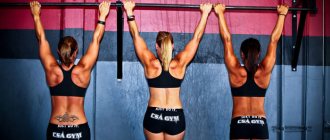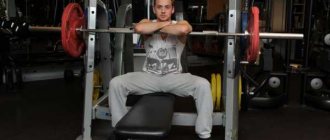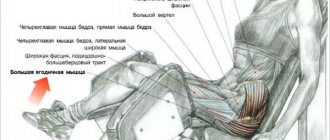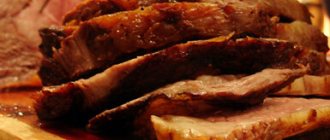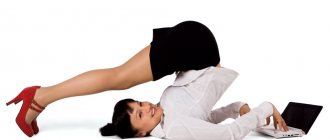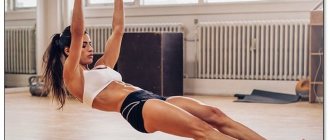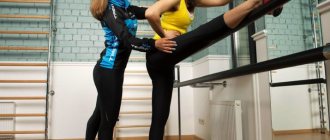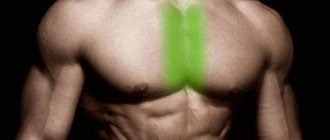What muscles work on the uneven bars?
Let's start with standard parallel bars exercises, where you stand between two pipes, take a stand and lower yourself. A lot depends on the angle and amplitude of the repetitions.
- For example, if you place your elbows out to the sides when doing dips, you will help stretch the lateral part of the pectoral muscle, which will enhance its development. In principle, the pectoral muscles are quite easy to pump in this way.
- If you press your elbows to your body while doing push-ups on the parallel bars, the emphasis is on the triceps.
- When leaning back, you can hit the same triceps and lats much more strongly.
Technique and rules for performing the exercise
The correct technique for doing dips is as follows:
- First, you need to warm up the muscle tissue of the upper torso and stretch the shoulder joints with simple warm-up exercises, such as swings and rotational movements of the upper limbs.
- Grab the parallel bars with an overhand grip, turning your wrists toward your body. Squeeze your shoulder blades and press your chin to your neck.
- Shift your body weight from your lower extremities to your upper extremities, and cross your legs at the ankles.
- Inhale through your nose and smoothly lower your body down, holding the bars with your palms and bending your elbows. When the body is at the lowest point, a right angle should form at the elbow bends.
- After holding in the lower position for a few seconds, until you clearly feel the stretching of the muscles, exhale through your mouth and begin to slowly rise to the upper position, avoiding jerking, swaying of the body and movements of the head.
To make it easier to master the correct technique of dips, it is necessary to adhere to the following rules during fitness classes and directly when performing this training movement:
- warming up before push-ups is mandatory and should not be neglected, as it helps to increase the effectiveness of fitness training and helps reduce the risk of injury;
- It is always necessary to start push-ups from the top position;
- to avoid body swaying, you should constantly tense your abdominal and buttock muscles;
- by pressing your elbows to your body, you can place a more accentuated load on the triceps, and if you spread your elbows wide and tilt your body forward, the focus of the load in the exercise will shift to the lower chest;
- At first, it is better to perform a version of push-ups on the uneven bars, more focused on the triceps muscles of the shoulders, and after mastering the skill of the correct technique, include in a fitness class a version of push-ups aimed at the muscles of the lower chest;
- the load should be increased gradually with weights as the muscles adapt to the working weight;
- the optimal distance between the bars, which allows you to minimize the risk of injury - slightly wider than the shoulders;
- it is important to perform the exercise slowly, since only in this case the muscles receive a high-quality and most effective load;
- During push-ups, you need to monitor your breathing, inhaling as you rise and exhaling in the lower position.
How to do parallel bars
By experimenting with grips, the load changes or accents are placed. And this is all just with the same type of exercises. The usual exercises that you did on the floor will be transformed into something different if you do it on the uneven bars. For example, push-ups. When performing them on pipes, the amplitude will be much greater, which will allow the pectoral muscle to be pumped very well. There is also a good exercise - a bench press from some surface, where you sit with your back against a bench, put your hands on it and only use them to lift your body horizontally, while your legs just lie on the floor. On uneven bars, obviously, the amplitude is also much greater.
The squat sit-up is a standard abdominal exercise. The problem that often arises on the floor is that when moving, the lower back rubs and becomes uncomfortable.
However, here you should be careful and control yourself. When training on uneven bars, you can lower your body very low. This could be beneficial if it did not cause harm to the spine. Everything needs to be done correctly.
Well, if you have imagination or just a desire to know more, then you can come up with so many different strange and very effective exercises. Such gymnastics on the uneven bars will only benefit you. In extreme cases, they can even be used as a horizontal bar, but you will have to pull yourself up with an angle.
But there is one problem with them - the risk of damaging the joints or getting a sprain. This can easily be corrected with a good warm-up and proper technique.
There are no particular contraindications for parallel bars , except for those who have problems with the same joints or those who do not consciously perform the approaches.
If you train in a hot head, just to do it, then there will be more harm.
The evolution of gymnasts' combinations on uneven bars
4e
The combinations of the 50s on the uneven bars were low-dynamic and consisted of simple lifts - an extension, two forwards and backwards, an inversion, as well as rotations in support in front and behind. This is due to the fact that the poles were brought so close that there was no talk of any amplitude of movements. Dismounts were simple half-flips from a handstand or a "kick". Sometimes the dismount could take the form of a forward or backward somersault from an emphasis while standing on the lower pole.
Get full text
Tutors
Unified State Exam
Diploma
4e
In the 60s, the distance between the poles was slightly increased. Accordingly, by the end of the 60s, gymnasts’ combinations significantly increased in dynamics, became much more complex, and increased two to three times in the number of elements.
The main difference between the combinations of the 60s and the 50s is the dynamics. The gymnast no longer takes unnecessary pauses between elements. The combination is constantly in motion. There is an alternation of ascents, revolutions and turns. The lifts themselves haven't changed much, but the quality of their execution certainly has. The same back lift is already done with an active back extension from the pole; the two forward lift is performed with a swing of the legs apart in each program. Moreover, the gymnasts mastered the transitions from n. and. to v. and. and vice versa, which we did not see in the 50s. These transitions are breakdowns from backward rotations while hanging bent over or from a back support, as well as an outside angle or a more complex version of the transition - from n. and. from a revolution back while standing an arc forward into a hanging position. Well, including with a 180 turn! Gymnasts use unused hanging turns in their combinations - “hangings”, that is, forward swing turns of 180 degrees. In addition, exercises are also used from a standing position. Czech gymnast Vera Caslavska inserts an even more interesting element into her program - from the front support, a swing with an approach and a 360-degree turn in a hanging position. Dismounts have changed radically. Now they are a forward arc from a standing turn with or without a 180 turn. Or a dismount with a break from the rotation backwards while holding in front.
Get full text
Coursework
Unified State Exam
Diploma
4e
In the 70s, gymnastics continued to develop at a rapid pace. The outstanding gymnast of the 70s is undoubtedly the Soviet athlete Olga Korbut. In 1972, she included in her combination a supernova and a complex element - the “Korbut loop”. This new product is a backflip from a standing position. and. in hanging on in. and. Olga also performs more complex elements with changing poles and a backflip dismount bending over from a standing position. and. through n. and.
By the mid-70s, gymnasts were making a revolutionary breakthrough in the development of combinations on the uneven bars! And in all directions. The attacks are becoming more and more diverse. Now it’s not just a hanging jump, but a running jump onto the bridge, and from there a forward somersault with your hips touching n. and. in hanging on in. and. or revolution from n. and. in hanging on in. and. Elements with changing poles become not just a mandatory “burden”, but also make a significant contribution to the complexity of the program. For example, gymnasts will perform a swing from a front position and a forward somersault into a hanging position. and. The somersault is performed facing the v. g., and with his back to v. and. (Radokhly somersault). From v. and. on n. and. gymnasts perform complex variations of breakdowns. For example, from a backward turn, bending into a support position from behind, or from a backward turn, with an outward angle into a standing position on the ground. and. The next most important step, which subsequently determined the development of parallel bars gymnastics as a whole, was the execution of handstand elements. In 1976, such elements became both a swing from a stop and a complex turn back without touching the stance. Elements with the flight phase have also become significantly more complex. Already in the mid-70s, gymnasts began to perform the so-called “Burda arc.” Already in 1970, Lyubov Burda performed a standing backward turn and a maneuver with a 360 turn, that is, the total turn was 540 degrees. Subsequently, gymnasts reached great heights in the virtuoso performance of this complex element. We also note the outstanding Romanian gymnast Nadia Comaneci, who showed a super difficult element in 1976. From the front support, swing and somersault forward with your legs apart and hanging! This marked the beginning of the era of flying elements on uneven bars of different heights. The level of difficulty of dismounts has increased several times. Now these are the original counter-flips forward after a forward arc from a standing rotation, which a little later began to be performed in a bent position, as well as with turns of 180 and 360 degrees. Nadia Comaneci performs an interesting modification of this dismount by performing a 180 turn in an arc and then a backflip. In 1978, Steffy Cracker performs a Comaneci dismount with a 360-degree turn. Dismounts with pushing off the hips from the v are also practiced. and. and backflips with 180 and 360 degree turns. Many gymnasts take up flying dismounts from a front support with a 360-degree turn.
Get full text
Just a year later, gymnastics on the uneven bars changes even more dramatically. Gymnasts begin to try to perform all elements through a handstand. For example, in 1977, in the combination of the outstanding Soviet gymnast Natalya Shaposhnikova, there is already a big turn back. It is performed using a special technology due to the small distance between the poles. The gymnast has to fold strongly on the descent from the rack, and then rise to the rack through a bend in the back. Natalya also performs the most difficult “Shaposhnikova flight” for those times, which is a turn back without touching the n. and. in hanging on in. and. And the dismount is also extremely unusual! If all the gymnasts performed dismounts, which are described just above, then Natalya will perform the “male” dismount with a double back somersault in a tuck. By the end of the 70s, gymnasts in the masses were performing large rotations, complicating them by swinging their legs apart (Stalder doing complex swings into a rack with turns. The combination began to more and more resemble the combination of gymnasts on the horizontal bar. This is also due to the fact that by the end of the 70s gymnasts master the Tkachev fly, which Alexander Tkachev performed in 1977, the Yeager somersault, pushing off from the lower body with the stomach, as well as the Voronin footstep and fly, flying the legs apart with a 180 turn while hanging. And here is the Korbut somersault, which by 1978 was used in combinations by many of the strongest gymnasts, it became a banned element. Let us note that in elements like “Korbut” the gymnasts showed ingenuity. For example, Elena Mukhina performed it with a 360 turn, and there was also a forward version of Korbut. That is from a standing position, a forward somersault with a hanging turn of 180. Let's note the most difficult dismount of Elena Mukhina... It consisted of a back turn in support (and later was performed from an emphasis without touching), a fall into forward flight through a pole and a counter back somersault in a tuck. Unfortunately, this dismount was an isolated occurrence and soon completely disappeared from the arsenal of gymnasts. But its potential is far from exhausted.
4e
Gymnast combinations in the 80s reached a completely new level of quality. But the fact is that in the late 80s the bars were further spread out (the distance between the poles was increased). That is, until the mid-80s, gymnasts’ combinations could still be called parallel bars combinations, but after that it was already a program on two bars. But first things first.
The combinations of gymnasts of the early 80s differ from the late 70s in that the masses of gymnasts begin to saturate their programs with all possible elements through the stand-up position as in v. well, so already in n. and. In almost every gymnast’s combination, you can find a turnover without touching the rack on the v. and. and n. g., Stalder, less often Endo. Transition from n. and. on v. and. It is usually carried out by a “fashionable” lifting of two legs forward, together or apart, with the release of the arms. In the opposite direction the transitions are different. From hanging breakdowns, bent over and flying back into the hanging swing. Basically, all the gymnasts’ efforts are aimed at studying elements with a flight phase. Nowadays you almost never see footsteps or Jäger somersaults by pushing off from the ground. and. - gymnasts finally move on to fully performing these hanging elements. If Tkachev's flight in 1979 could be performed by 5-6 top-level gymnasts, then in the early 80s this was already the norm. True, the path to the true Tkachev is long and difficult and will continue for a long time. The fact is that the gymnasts essentially performed “pseudo-Tkachev”. That is, they did a high swing forward, and then simply dropped back with their legs apart. There is no counter-tempo here as in the real Tkachev, there is no swinging of the legs over the bar. The evolution of this element was long and difficult. We also note that by 1983, gymnasts in the masses were performing not only the Yeager somersault, but also the Delchev somersault. This is interesting because the men abandoned the Delchev somersault almost immediately and switched to the Ginger. But gymnasts persistently did this somersault throughout the 80s. But since the 90s, it has also “died out” from their combinations. Natalia Yurchenko’s 1983 combination deserves special attention. Even then she managed to include into the combination a purely male complex sequence from Tkachev’s flight and immediately into the pace of Delchev’s somersault. The dismounts are becoming more and more similar to the dismounts of men on the crossbar. The most common is a double tuck back somersault dismount or a double back pirouette.
Get full text
By the mid-80s, the combinations did not change much in their construction. But some elements of the program certainly become more complex. For example, attacks. Gymnasts are increasingly beginning to experiment with complex lunges. For example, they perform a forward somersault on v. and. as from the side in. and. and through n. g., similarly with a swoop rondat - a twist or a swoop by Elena Gurova flak with a 360 turn on n. and. Elements with changing poles also become more complicated in the masses. For example, quite often (especially performed by Soviet gymnasts) you can see Shaposhnikova flying from N. and. on v. g., and with v. and. on n. and. Gymnasts usually fly by skidding. Moreover, you can also see a very difficult (especially if you take into account the small width between the poles) flight from the east. and. on n. and. using a backflip in a tuck (performed by Oksana Omelyanchik 1985). In a bending position, this somersault will become a regular in the combinations of almost all gymnasts of the 90s and beyond, and will be called the Pak somersault. Tkachev is added to the elements with the flight phase, but performed after Stalder - was first performed by Hana Ritsna, or the original, rare and very difficult flight of Elena Shushunova. It is a 360 turn, consisting of two 180 turns, and Tkachev, or to be precise, flying backwards with his legs apart. This was an attempt to perform a Tkachev flight with a 360 turn, but in relation to uneven bars. In 1988, Soviet gymnast Svetlana Kozlova demonstrated a unique element at union competitions - a triple back somersault into a dismount! It will appear in international rules only after ten years, performed by the Mexican gymnast Brenda Magana.
4e
The combinations of gymnasts of the 90s have evolved greatly compared to the 80s. Of course, a big role here was played by the fact that the bars were spread even further, and it became possible to even more fully use the potential of elements performed with a large swing. But that's certainly not all. After the 1992 Olympics the rules were changed. And in addition to complex elements, combinations of elements (even if not the most difficult ones) with each other began to be valued. This led to a change in the appearance of the combination and brought it to another qualitative level. If we talk about 1992, then this was the last year in which gymnasts “lived as before.” Of course, all the athletes squeezed everything they could out of their combinations. Almost everyone had two elements with a flight phase in combination. As a rule, Tkachev and Delchev, but there were exceptions. For example, the Korean athlete Kim Gwang Sook demonstrated a simply insane combination of a Tkachev fly and a counter-flip forward into a hanging position (in men's gymnastics, the Xiao Ruisi/Marinich somersault). Elements with a change of poles are, as a rule, a Shaposhnikova flight or a reverse rotation without touching it, but from inside the poles with a 180 turn. The dismount is already an order of magnitude more complex. For many gymnasts, this is a double back somersault in a tuck with a 360 turn, first performed by Oksana Chusovitina in 1991, or a double back somersault while bending over.
Since 1993, gymnasts have been searching for new types of combinations of elements. for example, combining a Jäger somersault or a Tkachev flight with a Pak somersault with a v. is becoming “in fashion.” and. on n. Well.. Or a combination of Chusovitina’s turntable (a large backward turn with a jump and a 360 turn) and some kind of flying element, for example a Ginger somersault or a Tkachev flight, is popular. But the most outstanding master of complex combinations of elements is the star of Russian gymnastics Svetlana Khorkina. It performs several connections in combination at once. For example, in 1997, after Stalder with a 360 turn, he immediately performed a large turn back with a 540 turn and immediately his signature Markelov flight. And her second sequence will serve for subsequent generations of gymnasts as an excellent example of the simplicity and genius of the idea - after the original big turn back with a jump and a 540 turn, there is a Pak somersault, then immediately Stalder on the n. and. and immediately its second nominal element is the flight of Khorkina or Shaposhnikov with a turn of 180 degrees.
Parallel bars training program
Thanks to the versatility of parallel bars, we have a variety that will help you correctly distribute the load on different muscles and increase the duration of your workouts. In principle, as in any other area, the training schedule on the uneven bars is approximately the same - daily or 3 to 1. The difference is that training on the uneven bars every day means strengthening, maintaining and a slight increase in overall tone. If you have a lot of free time and energy, you can do this workout on the uneven bars every day, and on some days you can also do another workout, up to the same muscles. This has a positive effect on overall fitness and discipline.
The order of the set of exercises on the uneven bars is as follows:
- Horizontal push-ups (15 times).
- Standard press (10 times).
- Back press (15 times).
- Press with elbows to the side (10 times).
- Shoulder press (12 times).
- Forward Bend Press (8 times).
- Reverse grip press (7 times).
- Walking on parallel bars with your hands.
Rest between sets for 70 seconds. It is advisable to perform the set twice, but this depends on your physical development. If it’s difficult, then start with one. Climbing is a finishing exercise that is recommended to be done at the end of a workout, not a circuit. The press that was described above serves to not reduce the intensity. It is in this text simply as an example of a good exercise, which, although similar to raising legs on a horizontal bar, is still different. However, if you want to burn more calories, then instead of resting between circuits, do this exercise.
results
| Place | Sportswoman | Base | For technology | Fine | Bottom line |
| 1 | He Kexin (CHN) | 7.700 | 9.025 | — | 16.725 |
| 2 | Nastya Liukin (USA) | 7.700 | 9.025 | — | 16.725 |
| 3 | Yang Yilin (CHN) | 7.700 | 8.950 | — | 16.650 |
| 4 | Beth Tweddle (GBR) | 7.800 | 8.825 | — | 16.625 |
| 5 | Anastasia Koval (UKR) | 7.300 | 9.075 | — | 16.375 |
| 6 | Ksenia Semyonova (RUS) | 7.400 | 8.925 | — | 16.325 |
| 7 | Stelyana Nistor (ROU) | 7.000 | 8.575 | — | 15.575 |
| 8 | Darina Zgoba (UKR) | 7.100 | 7.875 | 0.100 | 14.875 |
General Tips
Warm up well to avoid injury.
For beginners in sports who practice on parallel bars, you can try to perform only a standard bench press to get used to it.
For girls, standard dips and presses are better suited, instead of deviations and grip changes.
Push-ups come first in order to, to a greater extent, adapt the muscles to the next load, rather than the joints. The most trivial but important rule is that you train for yourself, not for someone else. This means that every repetition must be of high quality. Don't sag in your pace. Breathe. There is no need to hold your breath when performing difficult tasks. This will destroy your body before you even reach the end of the first circle. And drink water during your workouts. This technique will not only improve your performance during training, but also improve the result after it.
Features of the projectile
Gymnastic bars are suitable for everyone - small children, teenagers, adults, because the load comes solely from their own weight, and the hands must be trained in relation to the size of the body. If we are talking about comfortable and useful exercises in gymnastics, the width of the parallel bars must correspond to the age, which means you will have to either make them for a specific person, or simply practice on the parallel bars, because their width is adjustable. The distance between the parallel bars should be several centimeters wider than the shoulders; a larger distance can be traumatic, and a smaller distance will overload one muscle group, namely the triceps. So adjust the gymnastics bars so that they are comfortable, you need to tighten them so that they do not wobble or sway.
To avoid injury, you need to warm up; during exercises, you need to load evenly all the muscles that can work in a particular exercise. The parallel bars are not a horizontal bar; the important thing here is complex work, not pumping up a specific muscle.



